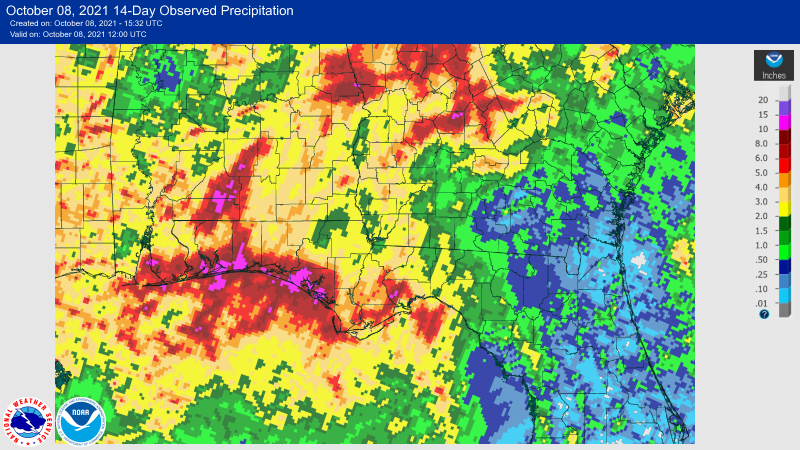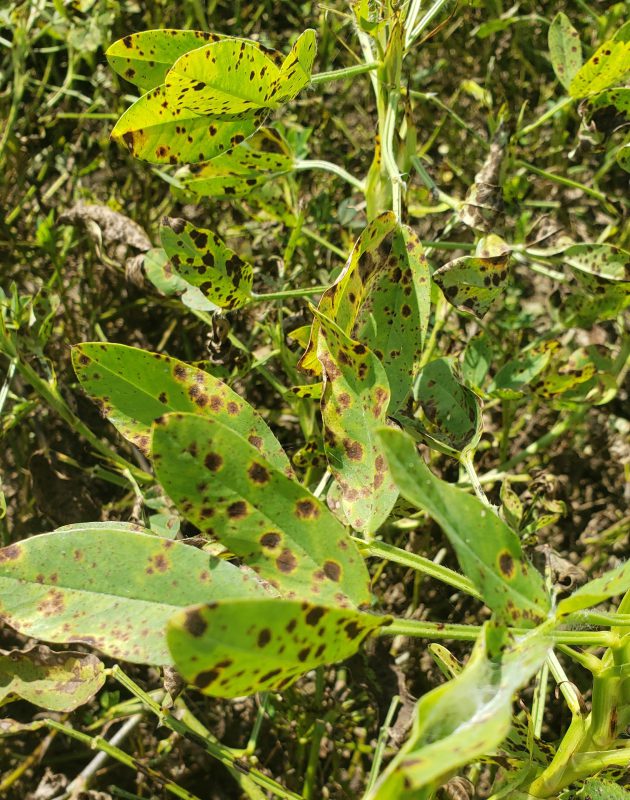Mark Mauldin, Ag & Natural Resources Agent Washington County, Dr. Barry Tillman, Peanut Breeder UF/IFAS NFREC, Ethan Carter, Regional Row Crop IPM Agent, and Camila Ichazo

Over the past two weeks parts of Florida’s Peanut Producing Region have seen incredible amounts of rain, while other areas have seen very little. The best harvest weather (less rain) was found mostly towards the southern and eastern parts of the region where harvest is nearly complete. Wet conditions have persisted for the central and western panhandle.
https://water.weather.gov/precip/
As we move into October leafspot, especially late leaf spot, continues to be the biggest concern for peanuts that are still in the ground. Leaf spot pressure is tremendous right now and fields that have not been adequately protected (because it’s been too wet to spray) are likely experiencing substantial defoliation. Additionally, in some areas foliage feeding insects are adding to the problem. At this point in the season most fields are mature enough to harvest (see the aGDD Tracker below), however wet conditions may me delaying the process. Not that any peanut farmer really needs me to tell them this, but, get ’em up as soon as you can. If you’re losing leaves you’re probably starting to lose pods. For June planted fields, defoliation, not maturity, may well dictate when the field needs to be dug. See Dr. Kemerait’s comments in the previous update for more details.
aGDD Tracker for the Florida Peanut Producing Region – 10/8/21 edition
The aGDD Tracker is compiled from data generated by PeanutFARM.org. The dark blue bars in the cells with the aGDD values indicates progress towards 2500 aGDDs. The bar extends to the right as aGDDs are accumulated. The entire cell will be dark blue when a field has accumulated 2500 aGDDs. Fields with aGDD values shown in orange have reached optimum maturity. It is recommended that fields be sampled and exact days-to-harvest be determined via pod-blasting once a field reaches 2300 aGDDs. These fields are shown in yellow.
–
If you have fields that are approaching 2300 aGDDs, contact your County Extension Office and make arrangements to have samples pod-blasted and analyzed. Remember, that the information generated will only be as good as the sample provided. Collect a good representative sample; dig (don’t pull) plants from several locations throughout the field, avoiding field edges and the ends of rows. Below is a link to a document that describes the entire maturity evaluation process in detail. Over the past two weeks, across all locations, fields accumulated approximately 100 aGDDs each week (down from 125, 136, and145 during the three previous two week periods), so plan accordingly. The declining rate of accumulation is expected as the days continue to shorten and temperatures cool. Even at this somewhat slowed rate of accumulation all but the absolutely latest planted fields should reach optimum maturity within the next two weeks. With that in mind, this will be the last aGDD Tracker published this season. Your feedback on this project is appreciated; if you found the Tracker useful or if you have an idea for how we can make it better next season please let me know.

